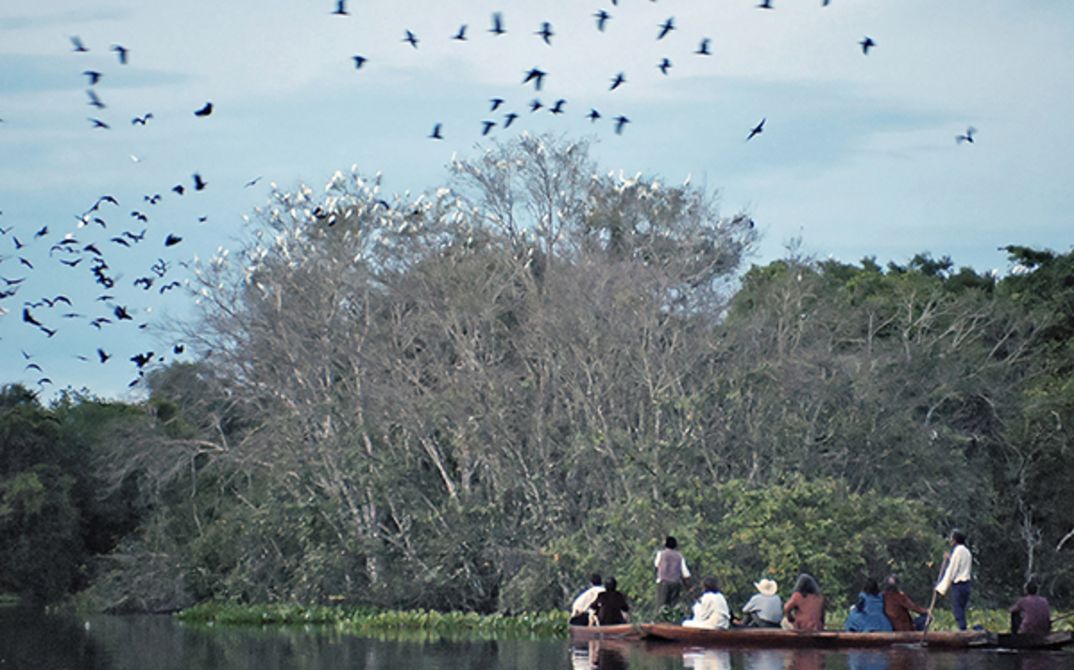The anchestors’ river and the flux of history
LUZ NOS TRÓPICOS is a fiction film about the clash between European rationality and tropical exuberance, in which geography and the body live in states of mutation, much like the water in rivers, which is a key element in the story of this film, my eighth feature. On a river that has been sacred to the Kuikuro Indians people since time immemorial, we witness the passage of time. For centuries, white explorers have navigated this river on their boats in search of aesthetic, economic, messianic, or anthropological ideals.
It is within this facet of memory, through characters who interweave and traverse unimagined, mysterious, and arid landscapes, often devoid of the abundance they had longed for, that the story of LUZ NOS TRÓPICOS unfolds.
The film is based on vestiges of various types of travel: nomadic movements, journeys, uprooting, and exile – central themes that already featured in my other films, such as THE VOLCANO EXILES and DAYS IN SINTRA. In the form of a perambulation, LUZ NOS TRÓPICOS is a cinematic fluvial-journal or cinema-journal – making contact with its characters in transit, both as encounters and as contamination. The film is an encounter with the other, a meeting of bodies, a contamination of forms (cinema, poetry, and performance). A cinema that creates life, existence, and, for this same reason, exile.
Three historical times coming together
In LUZ NOS TRÓPICOS two parallel journeys take place. One is real, concrete, taking place between sea and land and leading the protagonists to an encounter with a new world: the world of Brazil with its rivers, its nature, which was still preserved in the 19th century but would suffer ever greater destruction in the 20th and 21st centuries. The other journey is a subjective one, delving into memory and unveiling occult, overlapping worlds, such as those of the indigenous myths accessed by one of the protagonists when he returns to reunite with his Kuikuro ancestors.
LUZ NOS TRÓPICOS is a river movie in which three historical times come together in a world of polyphonic sonorities across different languages – Kuikuro, Portuguese, Russian, and Frenchto form a visionary, cosmological, and ancestral epic and thus open up a new field of perception, where possible and boundless worlds can be experienced.
Light is the central protagonist in the film. The impressionist relationship with light – at times violent and penetrating, like an arrow – forms the aesthetic spine of LUZ NOS TRÓPICOS. And, when one speaks of light, one also speaks of shadow – a duality that shapes every image, just as it shapes the history of cinema itself.
The film was shot using a range of media: digital, 16mm and Super 8. It also makes use of a number of iconographic images. The intertwining of these approaches allows for different textures in the images and opens up discussion about the transition from one medium to another (photography, cinema, and video). The mutation of the image raises important questions regarding the way the image is perceived – it is also in constant metamorphosis, in a process in which myths and people are superimposed, creating a world in a trance and a new relationship to the nature of things.
The light and the river
In LUZ NOS TRÓPICOS, characters and language are concepts that are frequently blended and distorted. While on the one hand there is a recognisable dramaturgy that relies on characters and dramatic cadence, on the other there are two major “characters” that connect them all: the light and the river.
LUZ NOS TRÓPICOS is a rhizomatic project. Its roots are in the water, they are floating spaces offering passage from one century to the next, carried along by the river. Just as the “foreign” characters are persistently unstable, dressed in new “interior states” within the flux of history, the Indians today, having suffered various threats and exploitation at the hands of white settlers, have to abandon their ancestral lands and live as nomads. They control the instruments of their own knowledge, of their own form of discourse, producing myths that are no longer what they used to be. This shifting spatiotemporal world in trance is visible in the film.
The script for LUZ NOS TRÓPICOS is original and not based on any pre-existing material. This is a project I began developing and researching in 2000. It is oriented by questions related to the image and its forms of representation, myths, and the history of Brazil and the world, based on a range of texts by Claude Lévi-Strauss, Pierre Clastres, Darcy Ribeiro, and Walter Benjamin, amongst others. It was also influenced by my first feature film, UAKÁ (CÉU), produced in the Kamayurá community of the Alto Xingú river in Brazil in 1988. (Paula Gaitán)
